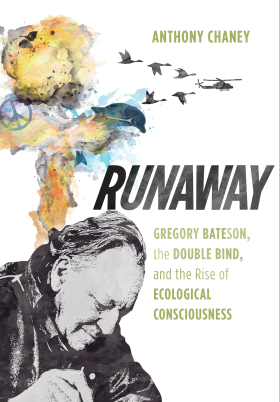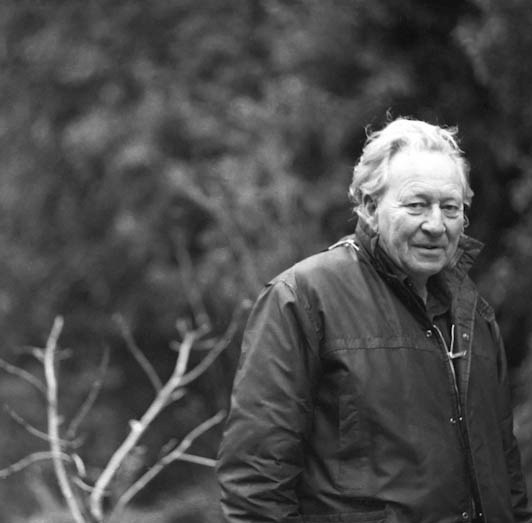The Book
Runaway: Gregory Bateson, the Double Bind, and the Rise of Ecological Consciousness
The Author(s)
Anthony Chaney
Editor's Note
This is the beginning of our roundtable discussion of Anthony Chaney’s book Runaway: Gregory Bateston, the Double Bind, and the Rise of Ecological Consciousness. Check back here for more entries the rest of this week–Robert Greene II, Book Reviews Editor.

Characterizing the long 1960s is the questioning of humanistic knowledge, science, religion, and liberalism shaking the foundation of modern America. This is where we find the polymath Gregory Bateson, anthropologist, communication and systems theorist, and public intellectual, attempting to resolve the deep contradiction of modernity and ushering in the postmodern age of information. Anthony Chaney’s book Runaway: Gregory Bateson, the Double Bind, and the Rise of Ecological Consciousness locates Bateson in the midst of a wide change in culture and social thought that had been in germination since the post–World War II Macy Conference on Cybernetics. Cybernetics, a key field for Bateson, is the interdisciplinary study of systems, their interfaces, and their communication, applicable to both organic and mechanical networks. He is remembered for his association with and failed marriage to Margaret Mead, an unexpected contribution to the field of clinical psychiatry in the “double bind hypothesis” of schizophrenia, and his book Steps to an Ecology of Mind (1972) (7). The theme that holds Bateson’s varied career together, and that makes him an apt symbol of the age, was the search to break out of modernity’s nature/culture, mind/matter, fact/value split, which he intuited as the source of cultural malaise. He viewed the ecological crisis as a “system in runaway” and unsolvable by the means that had produced it in the first place (3).
Before continuing, I must say that Chaney and I were graduate school classmates and have been friends ever since. Over the years, we discussed many of the points in his book, comparing notes on our mutual interests. Here is our recent podcast conversation. My objective here is to offer what I found to be the sweet spot of the book: not the narrative, which is very good; not even Bateson, a fascinating person; rather, it is the development of a set of ideas that, though recognizable, have yet to receive sufficient historical attention.
Runaway is neither a strict intellectual biography nor an environmental history, as its subtitle might lead one to believe. While it gives insights into the many working relationships in Bateson’s life, it does not present a thoroughgoing portrait of his psychology and motivations. It lacks the necessary political details of a public intellectual—especially of one who never built an institution or a movement, or even held a long-term commitment to one—yet who is clearly a pivotal figure. As environmental history, the book gives slight attention to the expected events and issues of political environmentalism such as industrial waste, nuclear power, and overpopulation. Chaney’s work becomes more ambitious and satisfying by focusing on the figure of Bateson as a harbinger for a germinating ecological consciousness
—a new epistemology still unfolding today.

Gregory Bateson, at home in Ben Lomond, California, 1975
What does Chaney mean by ecological consciousness? At first, I was drawn to the simple definition of a concern for the environment, one akin to the earlier conservation movement. It dawned on me after several conversations that the ecological consciousness that Chaney was interested in was an awareness that goes beyond environmental problems and instrumental solutions, to acknowledging the interdependent and blurred boundaries between humanity and the natural and cultural environment.
This interconnectivity is today the subject of complexity studies, encompassing such diverse disciplines as biology and literary studies focusing on communication across systems. All the disciplines and much of the cultural conversation is more mindful of the interdependent nature of human experience. As an intellectual historian, I am sensitive to the dizzying number of disparate sources and the complex of context. The world appears labyrinthine, escaping simple either/or explanations.
Bateson explored deep interconnectivity, posing a problem for the idea of human agency. Addressing the problems of modernity means encountering a double bind—an impossible dilemma in which the hubris of instrumental solutions elides the embeddedness of human life in the environment we seek to control. How to address common problems, of which the natural environment and its limits are not the least, is often a case of the blind leading the blind. Grappling with the double bind, which Bateson helped to define, means acknowledging human action as being caught in a loop of responding to a continually active environment, triggering unforeseen consequences in the whole system, which in turn shapes human experience. The experience of decision paralysis challenges the human agency, power, and freedom that are widely accepted as immutable.
As an autodidact, Bateson was not afraid to venture beyond his initial training in anthropology; he achieved mastery in multiple disciplines, including game theory and semiotic theory. He participated in cybernetics research and led the double bind research group of psychiatrists who were studying family systems of schizophrenic patients. The research group gathered a huge amount of patient data and examined it for patterns—an early, analog attempt at big data. In the 1960s, he studied dolphins at the Oceanic Institute and Sea Life Park, not motivated by the “dolphin mystique” but in search of evidence for his evolving communication theory (106). By 1967, Bateson was applying his communication theory to culture and presenting at the radical Congress on the Dialectics of Liberation in London, a gathering of the avant-garde left, such as Allen Ginsberg, Herbert Marcuse, Stokely Carmichael, and Paul Goodman. It was described by a participant as a place where “the revolutionary left met the mindblowers,” two divergent views of how to confront systemic oppression (213). This was the stage for Bateson’s Great Refusal.
The age-old materialist/romantic divide permeated the London gathering. In his lecture, Bateson critiqued action and the instrumental approach to social problems, cutting through the evident conflict between structuralists and culturalists. Structuralists were focusing on changing political and social institutions through revolution; culturalists focused on change in the psyche, chemically induced or otherwise. Both positions needed interrogation, as they depended on human autonomy that elided the human–environmental relationship Bateson had studied for decades. What began as an inquiry into organic and mechanical systems had a political echo at the London gathering. He offered a holism that encompassed an integrated individual, society and the ecosystem maintaining an “uneasy balance between dependency and competition” (218). His criticism was of modernity itself, charging that those who railed against it were operating from within the same mental frame. At stake was the possibility of an “ecocatastrophe,” the result of a total system in runaway mode seeking equilibrium. Bateson offered a theory of mind and the possibility of re-enchanting the world by regenerating the bonds of communication that modernity had torn asunder (214).
Grounded in evolutionary science, Bateson’s views were not conventionally religious, rejecting the notion of the supernatural or mystical. But his total theory of interconnectedness, as an attempt to explain reality, left, in my estimation, a ghost in the machine in which a system is greater than the sum of its parts. This might be understood today as a residue of spirituality. Chaney does not offer an examination of the mystical Bateson but provides a telling Bateson quote: “I am inclined to regard the total systemic creature, you see, as mind, and the total systemic ecology as mind, and the culture as mind…Call it God, if you like.” (218) Along with Bateson, the religious intellectuals of the 1960s that I study were also questioning modern theology and seeking a higher synthesis that went beyond the split between the sacred and the profane, between a God above and divinity within. This is the ecological consciousness that Bateson pursued—the search for union with the community, the earth, and the self that would avert an ecological apocalypse.
As a work of intellectual history, Runaway
breaks new ground in revealing the complexity of our political, social, and environmental quagmire. Chaney has engaged history in the task of cultural criticism. Like most books that explore the human condition, it is not optimistic, and its contemporary significance is hard to miss. Many solutions for our current all-encompassing crisis are on the table; few guarantee success. Communications and information networks are global and increasingly intricate. We find ourselves in a double bind, pinned down by the feeling of “damned if we do, damned if we don’t.” If the beginning of wisdom is acknowledging the ground of being on which one is dependent, then Chaney’s Bateson offers the possibility of this recognition and constructing new ways of thinking about the world. Runaway
clarifies not only the impasse of today’s ecological crisis but illuminates the fundamental flaw at the bottom of our us-against-them politics in a world in which we are all deeply linked.
About the Reviewer
Lilian Calles Barger is an intellectual and gender historian. Her book entitled The World Come of Age: An Intellectual History of Liberation Theology is forthcoming in August, 2018 from Oxford University Press. She is currently researching the history of feminist thought and the gender revolution.

0